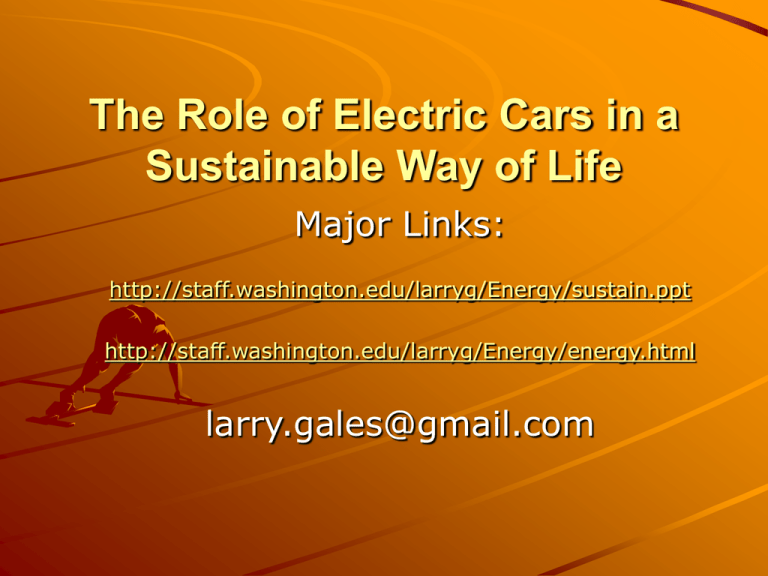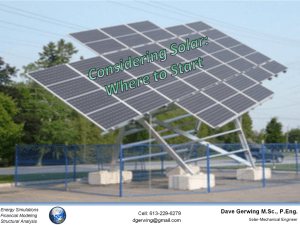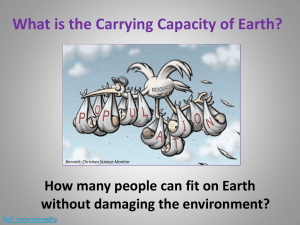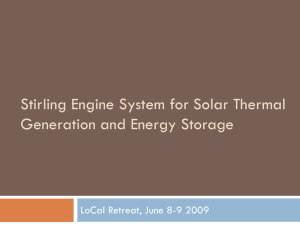The Role of Electric Cars in a Sustainable Way of Life
advertisement

The Role of Electric Cars in a Sustainable Way of Life Major Links: http://staff.washington.edu/larryg/Energy/sustain.ppt http://staff.washington.edu/larryg/Energy/energy.html larry.gales@gmail.com My main interest in electric cars lies in their role in moving us toward a sustainable way of life. The biggest barrier to this goal is its perceived cost. Yet my back-of-the-envelope calculations below indicate that a net-zero energy house and net-zero energy automobile combination would be much cheaper over 35 years for a household than our current use of energy. All costs assume *NO* subsidies. Specifically, a typical household today will spend over $140,000 in energy over the next 35 years for house and cars, whereas a net-zero energy house and car combination would cost about $100,000 for the same time period. Below are the calculations, references, and data for such a conclusion. Here is the list of my estimates for various costs, as well as references that I use in my calculations. Note that all cost estimates are in *TODAY'S* dollars as I exclude inflation from the calculations. Estimates for energy cost for a conventional house-car scenario My estimate for annual household energy costs: $2350/yr. Average electrical costs: $1200/yr: http://tiny.cc/electric443 Average household heating costs ($769-$2349): http://tiny.cc/heating Estimates for energy cost for a conventional house-car scenario My (conservative) estimate for current MPG: 30. Ref: current MPG My (conservative) estimate for the cost of a gallon of gas in today's dollars: $2.50. National average cost/gallon as of 10/26/2009 was $2.67. Ref: National average cost/gallon> Estimates For Energy Cost … My estimate for household miles driven per year: 21,000 (based on usually more than one car per household). Ref: 21,000 miles So, the energy cost for the conventional house-car scenario over 35 years is: ( $2350 + (21000/30)*$2.5) ) * 35 = $143,000 Estimates for net-zero energy house as of 2009 The European passive house: my estimate is that building to this standard would increase the cost of a house by an average of 10%. They are called passive houses because they do not require active systems such as ground-source heat pumps or solar PV arrays. The only active element is forced air ventilation through heat exchangers. Note that the "European passive house" is not at all the same as the term "passive house" that is used in the US: it is a very specific and advanced technology that reduces energy costs far more than is achieved by passive or even most active solar houses in this country. Estimates for Net-Zero … Thousands of these houses have been built across Europe. They look like ordinary houses, apartments, condominiums, etc. They tend to be more comfortable, much quieter, have healthier indoor air quality, require less maintenance, reduce heating/cooling costs by a factor of 5 or 10, eliminate the need for a central heating/cooling system, and use 4 times less energy overall. Here are other estimates for the additional cost of a European passive house design: Ref: 5-7% in Germany Ref: 4-5% Ref: up to 14% And here is reference to the savings in energy use: Ref: 75% less energy Estimates for Net-Zero … Comparison of Standard House w/ Passive House Heat Exchanger for Passive House 75% Reduction in Energy Use Estimate for Net-Zero … My estimate for the cost of an average house in the US as of 2009: $240,000. This is a high estimate based on combining 3 regional estimates for Western, Eastern, and Southern houses in the US. Ref: House costs My estimate for the cost of a home energy monitor: $500. Ref: $200 - $600 My estimate for the cost of solar hot water heating: $10,000. Ref: 4000 Euro/$5600 Ref: $10,000 - $18,000 Ref: $9000 - $15,100 for *cold* Northern states as per "Solar Today", June 2009, page 40. Solar heaters in "average" locations in the US should be cheaper than in Northern states. Estimate for Net-Zero … My estimate for *current* PV solar cost is $8/watt. Ref: $7.6-$8.10 My (conservative) estimate for PV degradation is 1.00%/year. Ref: appears to be less at 0.75%/yr My (conservative) estimate is that in an average location in the US, over a 35 year lifetime, a 1 KW PV array will generate an average of 1100 KWH/yr. This is based on the average 1st year output of 1300 KWH/yr for a 1 KW PV array, degrading over 35 years at 1%/yr to 900 KWH/yr: (1300 + 900)/2 = 1100 KWH/YR. Ref: PV watts per state Estimate for Net-Zero … Currently, the average house in the US consumes about 11,000 KWH/year of electricity. Ref: 936 KWH/mo and a similar dollar amount in natural gas or oil heat. By combining the efficiency of a European passive house plus an energy monitor plus solar hot water heating we should reduce the TOTAL amount of energy needed by the house to 5000 KWH/year. So a 5 KW solar PV array, which produces an average of 5500 KWH/year for 35 years will convert this house into a net-zero energy house. It is still connected to the electrical grid, but it simply uses the grid as a giant storage battery, sending as much energy back to the grid as it consumes, running the house electric meter backwards, and so the average annual energy cost for this house is $0.00 for the next 35 years. Estimate for Net-Zero … So the total cost of this upgrade is as follows: - European passive house design: 10% of $240,000 = $24,000 - Energy monitor: $ 500 - Solar hot water system: $10,000 - 5 KW PV array at $8/watt: $40,000 TOTAL COST: $74,500 Estimates for the energy cost for electric cars We will give this family 3 electric cars: one full size full function 5-6 passenger, high performance electric car, and two tiny 8x5 foot 900 lbs. electric micro cars limited to 35 MPH. The high performance family electric car is superior to a gas equivalent car in almost every way, except for range and recharging time, due to the qualities of electric motors and the architectural design freedom of electric drive trains. If designed from scratch it should get 4.5 miles/KWH. Ref: the 2850 lb. EV1 got 5.5 miles/KWH Ref: the 3000+ lb Chevy Volt gets 40 miles on 55% of its 16 KWH battery, and so gets 4.5 miles/KWH. Energy … Electric Cars There are a number of cultural, safety and other reasons why Americans do not like micro cars, such as the SMART car. However, some of these reasons are due to the fact that downsizing a gas engine car makes it uglier, noisier, dirtier, less efficient, and much more cramped. This is because gas engines are such obnoxious devices that they must be surrounded by all sorts of other things to make them acceptable, such as mufflers, catalytic converters, variable speed transmissions, fuel, cooling, and oil distribution systems, pumps, belts, hoses, filters, etc. And it is these very things that get heavily compromised when the car is greatly downsized. But electric motors are always quiet, clean, smooth, and efficient regardless of their size; and limited performance (say, 35 MPH) lightweight cars can be designed where the drive train takes up zero space: the battery, charger, and inverter can be a long, wide, but thin pack that makes up the floor of the vehicle (taking up no space), and the 4 motors are inside the wheels. Thus a tiny 8x5 foot car that is 10 inches shorter than a SMART car and 1 inch narrower may still be able to hold 4 adults. So there is reason to believe that a tiny electric car may be more acceptable to the American public. Eneryg … Electric Cars Each of the two micro cars is assumed to get 12 miles/KWH (this compares with the Aptera which is almost twice as heavy and far more powerful and which gets 10 miles/KWH). Aptera 2E If the micro cars drive a combined total of 13,000 miles/year, and the full size car drives 8000 miles/year, then the theoretical annual KWH/year is (8000/4.5) + (13,000/12) = 2860 KWH/year. However, there are various losses of efficiency, such as wall plug-to-battery and other losses. So we build in another 25% loss in efficiency, to get to 3575 KWH/year. Energy costs for the net-zero energy house and car combination So a 3.5 KW solar PV array will generate an average of 3850 KWH per year, and will more than cover all of the energy costs for all 3 cars for 35 years. This adds $28,000 to the overall cost of the house. So the total cost of energy for the net-zero energy house and netzero energy cars is: - Passive house + 5 KW solar PV: - 3.5 KW PV solar for the 3 cars: $ 74,500 $ 28,000 - TOTAL energy costs for 35 years: $102,500 Thus we have $102,500 for the net-zero energy house/car combination versus $143,000 for the conventional house/car combination. Current situation versus the near future However, there is a problem right now: the only real electric car in mass production is the $109,000 super-high performance Tesla Roadster, which at 0-60 in 3.9 seconds leaves most Corvettes, Dodge Vipers, and Ferraries in the dust. Ref: Tesla Motors But all that is about to change. In 3 years, by 2012, there should be a sizable number of electric vehicles available (Nissan, Aptera, TH!NK, iMiev, Chevy Volt, Tesla White Star). Ref: Nissan Leaf Tesla Roadster Nissan Leaf Current Situation Versus … In addition, in 3 years the cost of solar PV will significantly decline. My (conservative) estimate for PV solar in 2012 is $5.60/watt. Until 4 or 5 years ago, PV costs were declining until they hit a plateau determined by the supply of purified silicon (the supply was set by the electronics industry, not PV). But that has changed and the supply is growing so that the cost of purified silicon is dropping by a factor of ten. This, as well as many other reasons, is why the cost of PV will plunge. My estimate assumes a reduction of 30% by 2012, but others predict a steeper decline. Ref: $1/watt cell ~ $4/watt for PV The current cost of the 8.5 (5 + 3.5) KW solar array for the house and cars is 8500*8 = $68,000. But in three years this should drop by (5.6/8) *$68,000 = $47,600. So then the total energy cost of the net-zero energy house and car combination should be $24,000 + $500 + $10,000 + $47,600 = $82,100, compared with $143,000 for the conventional house/car combination. Current Situation Versus … Note: all of these calculations are for an average house in an average location in the US. However, there is about a 35% variation, plus or minus, in solar intensity in the contiguous states. For example, in Tucson, a 1 KW PV array produces 1663 KWH/year, whereas in Seattle (where I live) it produces 970 KWH/year. So, looking at the cost of solar PV, the PV cost of $47,600 should be modified by +/- %35. So in Tucson, the 8.5 KW PV should cost about $31,000, whereas in Seattle, it would cost about 64,300. This would yield total costs as follows: - Tucson: $24,000 + %500 + $10,000 + $31,000 = - Seattle: $24,000 + %500 + $10,000 + $64,300 = $65,500 $98,800. So even in Seattle, the cost is much less than for a conventional house. The Energy Efficiency of Electric cars There is a myth that Electric cars (EVs)merely shift the emissions from the car to the power plant. This is based on the following data: If an electric car gets ALL of its energy from a coal power plant (the dirtiest kind), it only reduces the total emissions by 30% compared with regular gasoline cars. So an EV would produce about 70% of the emissions of a gas engine car. But a hybrid car reduces emissions by 40%, and so a pure electric car produces somewhat more emissions than a hybrid car However, this assumes that we get ALL of our electricity from coal. In fact, as the chart below shows, we only get about half of our electricity from coal. Of the remaining 50%, 20% comes from natural gas, which produces only 1/2 the emissions of coal, and 27% of the remaining 30% (nuclear, hydro, wind, solar, geothermal, ...) produce almost 0 emissions. So, if EVs produce 70% of the emissions as gas engine cars when they get their electricity from coal, and the current electrical grid produces only 60-70% of the emissions from coal, EVs would produce only (0.6 * 0.7 = 42%) to (0.7 * 0.7 = 49%) of the emissions of gas engine cars which makes them cleaning even then hybrids. The Energy Efficiency … The Energy Efficiency … So EVs would produce ½ the emissions and would be twice as energy efficient as gas engine cars. However, there is much more to the story than that. As was demonstrated above, getting the electricity from your rooftop PV array makes very good economic sense and exceptionally good environmental sense. Consider this scenario: Your EV gets 4.5 miles/KWH, which is reduced to 3.6 miles/KWH when all inefficiencies are counted in You drive 12000 miles/year, and so you use 3333 KWH/year A 3.1 KW PV array will generate in excess of 3400 KWH/year, and at $8/watt, will cost $24,800. Add, say, $2200 for maintenance over 35 years (mainly the inverter) and your cost is $27,000. The Energy Efficiency … At $2.50/gallon, and at 30 MPG, your gasoline cost will be $35,000 over 35 years. So the EV is 22% less expensive to run. But PV arrays produce at least 10 times as much electricity as is required to build them. So, not only does running your car off of your own PV array make sense, but it reduces the overall emissions by a factor of 20 compared with a gasoline engine car. In fact some PV arrays, based on thin film cells which are now becoming competitive with silicon PV cells, produce nearly 30 times as much energy as required to build them, thus reducing overall energy and emissions by a factor of 50 to 60. The Energy Efficiency … The Energy Efficiency … So now we are talking about really huge differences between EV and gasoline engine cars. But the difference does not even stop there. A factor that is seldom considered is the energy needed to extract, refine, and distribute oil/gas to the transportation sector. For example, in California, 4.5% of all the electricity and 9% of all the natural gas is used just for the extraction and refining of oil. This was based on the URL: http://www.energy.ca.gov/pier/iaw/industry/petro.html which appears to be no longer valid. A study by Nissan indicates that it takes 7.5 KWH to refine one gallon of gasoline. At 3.6 miles/KWH, that will take an EV 27 miles, about the same distance that a gallon will drive a gas engine car. So in fact, we see that gas cars use as much electricity/mile as EVs, but in addition consume huge amounts of gasoline. It may turn out that if we were all driving EVs, we would actually reduce the amount of electricity we use, as well as radically reducing the use of fossil fuels. This probably does not even include the amounts of energy needed for the exploration, transport, and distribution of oil and its products. So EVs are enormously more efficient that gas engine cars, not to mention the huge savings in materials and energy needed for maintenance. The Energy Efficiency … So EVs are enormously more efficient that gas engine cars, not to mention the huge savings in materials and energy needed for maintenance. But we are not done yet: within the next 10 years we will likely see V2G: vehicle to grid technology in place. Ref: http://www.udel.edu/V2G By far the weakest part of our energy system is energy storage, which has always been too expensive. But if we use the batteries in EVs, for grid storage, the batteries are already paid for. Making use of this storage would not be a problem for an EV owner. Lets assume that their battery gives them a range of, say, 150 miles on a charge. Since the average trip per day is less than 40 miles, the EV owner could use a “smart” phone to tell the car to allow for, say, 50 miles of energy to be sent to the grid. If they need a longer range, they could turn off the energy sharing feature for a day. It is estimated that if we were all driving EVs, the energy stored in the car’s batteries would equal 5 times the total electrical generating capacity of the USA, and that it could earn each EV user up tp $4000 per year by selling electricity to the grid. Ref: http://en.wikipedia.org/wiki/Vehicle-to-grid Better Ways to Finance However, there are two problems with costs that we have not considered: The costs are all up front. The net-zero energy house/car combination may cost $40,000 less than a conventional house/car combination, but the $100,000 cost is all up front. And we have not included the costs of the electric car itself, which may be very high due to the high cost of batteries. http://news.cnet.com/8301-11128_3-9907982-54.html Better Ways to Finance To answer the first problem, several companies have created a different financing model for the most expensive part of the net-zero energy system: the solar PV arrays. They install the PV arrays for a small up front fee, say $1000, and then charge you for the electricity that you use. SolarCity, a California firm is one such example. They will install a PV array for $1000 to $3000, depending on the size of the array, and then charge you for the electricity they make. Customers who use a substantial amount of electricity will save money compared with their current electric bills. But since the net-zero energy houses descibed in previous slides will dramatically cut all energy costs, this financing should lower the cost for all users. Ref: http://news.cnet.com/8301-11128_3-9907982-54.html Better Ways to Finance To handle the 2nd problem, some EV firms plan to sell you the car, but only lease the batteries. The reason for this, is that an EV is extremely simple, and ultimately should be much less expensive to produce than a gas engine car, but the batteries are very expensive. However, the batteries have the potential for a long life as energy storage devices after they are used in a car. So by selling you the car, but leasing the batteries, the firm can reclaim the batteries after they no longer provide sufficient power for the car, but can serve for decades as energy storage devices. He Nissan Leaf is one such example: the car will sell for only 1-2% more than a gas engine car with comparable performance, safety, convenience, and passenger/cargo size, but you will be charged a monthly battery fee based on the number of miles you drive. That fee, however, should be less than the operating cost of a gas engine car. Ref: http://tiny.cc/Leaf Other Advantages So we see that the net-zero energy house/car combination actually costs less than conventional house/car combinations. But that is only one of the advantages. Here is the list of advantages: Much lower cost over 35 years Fixed energy costs as opposed to highly volatile costs Energy security: even if the grid goes down for extended periods of time, you will always have enough energy for vital services Much lower maintenance cost for both house and cars Quieter and more comfortable house and cars. -- Larry







